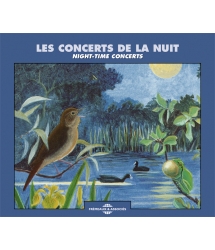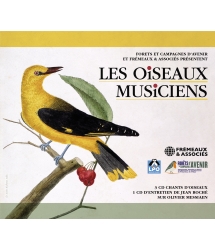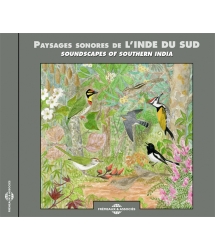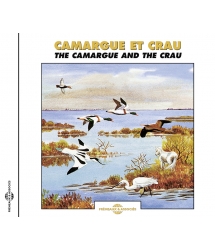- Our Catalog
- Philosophy
- Philosophers of the 20th century and today
- History of Philosophy (PUF)
- Counter-History and Brief Encyclopedia by Michel Onfray
- The philosophical work explained by Luc Ferry
- Ancient thought
- Thinkers of yesterday as seen by the philosophers of today
- Historical philosophical texts interpreted by great actors
- History
- Books (in French)
- Social science
- Historical words
- Audiobooks & Literature
- Our Catalog
- Jazz
- Blues
- Rock - Country - Cajun
- French song
- World music
- Africa
- France
- Québec / Canada
- Hawaï
- West Indies
- Caribbean
- Cuba & Afro-cubain
- Mexico
- South America
- Tango
- Brazil
- Tzigane / Gypsy
- Fado / Portugal
- Flamenco / Spain
- Yiddish / Israel
- China
- Tibet / Nepal
- Asia
- Indian Ocean / Madagascar
- Japan
- Indonesia
- Oceania
- India
- Bangladesh
- USSR / Communist songs
- World music / Miscellaneous
- Classical music
- Composers - Movie Soundtracks
- Sounds of nature
- Our Catalog
- Youth
- Philosophy
- News
- How to order ?
- Receive the catalog
- Manifesto
- Dictionnary











- Our Catalog
- Philosophy
- Philosophers of the 20th century and today
- History of Philosophy (PUF)
- Counter-History and Brief Encyclopedia by Michel Onfray
- The philosophical work explained by Luc Ferry
- Ancient thought
- Thinkers of yesterday as seen by the philosophers of today
- Historical philosophical texts interpreted by great actors
- History
- Books (in French)
- Social science
- Historical words
- Audiobooks & Literature
- Our Catalog
- Jazz
- Blues
- Rock - Country - Cajun
- French song
- World music
- Africa
- France
- Québec / Canada
- Hawaï
- West Indies
- Caribbean
- Cuba & Afro-cubain
- Mexico
- South America
- Tango
- Brazil
- Tzigane / Gypsy
- Fado / Portugal
- Flamenco / Spain
- Yiddish / Israel
- China
- Tibet / Nepal
- Asia
- Indian Ocean / Madagascar
- Japan
- Indonesia
- Oceania
- India
- Bangladesh
- USSR / Communist songs
- World music / Miscellaneous
- Classical music
- Composers - Movie Soundtracks
- Sounds of nature
- Our Catalog
- Youth
- Philosophy
- News
- How to order ?
- Receive the catalog
- Manifesto
- Dictionnary
AMBIANCES NATURELLES - SOUNDS OF NATURE
Ref.: FA615
Artistic Direction : OLIVIER PROU
Label : Frémeaux & Associés
Total duration of the pack : 1 hours 12 minutes
Nbre. CD : 1
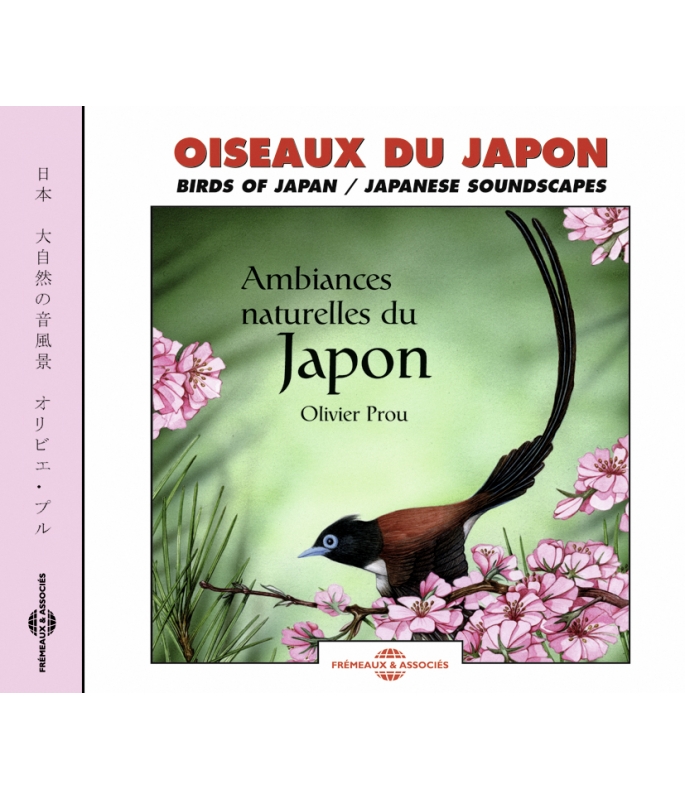
AMBIANCES NATURELLES - SOUNDS OF NATURE
AMBIANCES NATURELLES - SOUNDS OF NATURE
Olivier Prou presents, for the first time on CD, the natural soundscapes of Japan, with 14 natural shows. This international edition features a French-English-Japanese booklet. Patrick Frémeaux
From the northern mountains to the southern islands of Japan, Olivier Prou guides us through the very poetry of the birds’ voices associating here and there sounds of nature such as the wind rustling in the trees, and the waves crashing on the shores. Philippe PONS, press correspondent in Japan for the newspaper Le Monde
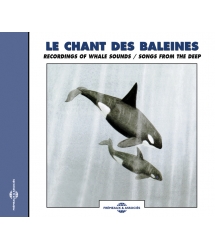
SONGS FROM THE DEEP - RECORDINGS OF WHALE SOUNDS
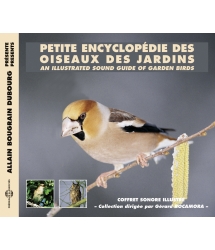
AN ILLUSTRATED SOUND GUIDE OF GARDEN BIRDS
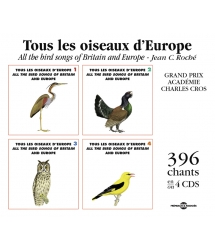
ALL THE BIRDS SONGS OF BRITAIN AND EUROPE
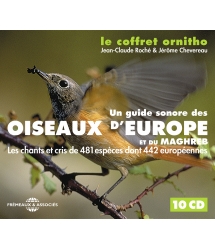
ORNITHOLOGICAL SOUND ENCYCLOPAEDIA :10 CDs





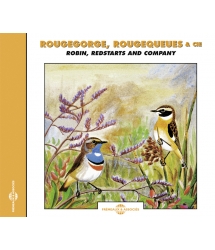
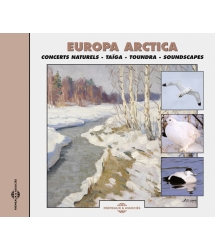
-
PisteTitleMain artistAutorDurationRegistered in
-
1CONCERT DE L AUBE00:06:192006
-
2CHUCHOTEMENTS DE BATRACIENS00:03:102006
-
3SYMPHONIE JAPONAISE AU COEUR DU PARC NATUREL00:04:322006
-
4APRES L ORAGE DANS LA FORET D ASHU00:09:552006
-
5NOCTURNE DANS LA RIZIERE D IWAKURA00:02:292006
-
6CREPUSCULE MYSTERIEUX00:05:032006
-
7BRUANT MASQUE A L OREE D UN SOUS BOIS00:01:432006
-
8BAIN DES GOELANDS00:03:352006
-
9FRAICHEUR D UN MATIN CALME00:10:302006
-
10REVEIL DU GRAND NORD00:07:252006
-
11SUR LES HAUTEURS DE YUWANDAKE00:05:292006
-
12NUIT CLAIRE SUR L ILE D AMANI00:06:292006
-
13CHOEURS D AMPHIBIENS00:02:182006
-
14MER ET MONTICOLE BLEU SUR L ILE DE KAKEROMA00:03:042006
OISEAUX DU JAPON
OISEAUX DU JAPON
BIRDS OF JAPAN / JAPANESE SOUNDSCAPES
Ambiances naturelles du Japon
Olivier Prou
Ambiances japonaises
“On connaît le sentiment de communion des Japonais avec la nature. L’homme se sent appartenir à la totalité de celle-ci plus qu’il ne pense pouvoir la dominer. Abondamment représentée dans la peinture et évoquée dans ses variations saisonnières, ses frémissements et ses détails infimes dans la poésie, - en particulier dans la fulgurance illuminatrice du haïku -, la nature est certes paysagère mais elle est aussi faite de bruits. Des sons dont la langue japonaise s’est efforcée de rendre les nuances avec une multitude d’onomatopées : notamment l’infini registre de la “voix” (koe) des oiseaux ou des insectes dans un pays dont l’étendue offre, par sa large gamme climatique, une faune (et une flore) d’une étonnante variété. Au nom scientifique de certains se substitue dans la langue courante ce que l’homme a cru entendre de leur chant : “mininminin” dira-t-on de telle cigale ; “hohokekyo” du rossignol… Des “voix” auxquelles, les haïkistes ne sont pas insensibles : “La fin de ton chant, coucou, je l’entendrai aux Pays des ombres ” (Anonyme). C’est à cette poétique de la “voix” des oiseaux, avec parfois en arrière fond le bruissement du vent dans les feuillages ou le fracas des vagues, que convie Olivier Prou qui, du grand Nord nippon aux îles méridionales, s’est laissé porter par le “charivari” du vivant.
Philippe PONS, correspondant du journal Le Monde au Japon
Japanese Soundscapes
The Japanese are famous for their close relationship with nature. They feel they are part of it rather than dominating it. Nature is widely represented in paintings and described throughout poetry in all its seasonal variations, its most delicate details and flutterings – especially in the haiku; it is certainly both a visual and an aural art. The Japanese language conveys the slightest nuances of natural sounds through a wide range of onomatopoeias, particularly the infinite register of bird and insect “voices” (koe) in a country which offers, thanks to its wide climatic range, an astonishing variety of animals and plants. In everyday language people prefer phonetic transcriptions of the sounds they hear, “mininminin” for the cicada, “hohokekyo” for the nightingale, etc… to the scientific names. Haiku writers are also inspired by these “voices” : “The end of your song, o cuckoo, I’ll hear in the land of shadows”. Olivier Prou invites us to listen to this poetry of birds’ “voices” in company here and there with other sounds of nature such as wind rustling in the trees, and waves crashing on the shore – from the northern mountains to the southern islands of Japan.
Philippe PONS, press correspondent in Japan for the newspaper Le Monde
Introduction
Vous découvrirez dans ce CD la beauté et la richesse des ambiances naturelles du Japon. Les médias nous diffusent régulièrement l’image d’un Japon avant-gardiste, hautement technologique et industrialisé à l’extrême, où la nature a peu de place. S’étirant sur 3000 km, l’archipel nippon est pourtant recouvert à 80% de montagnes et de forêts d’une étonnante biodiversité. Ses régions aux climats variés -de subtropical à subarctique- nous offrent des ambiances sonores contrastées. Certaines espèces présentées dans ce CD sont endémiques, parfois rares et difficiles à enregistrer, comme le Pic à dos blanc de Owston, la Grive d’Amami, le Geai de Lidth ou le Rossignol komadori. Si les oiseaux occupent la plus grande partie du CD, une place a été laissée aux amphibiens, dont les chants rythment les nuits de printemps dans les nombreuses rizières et forêts du pays.
Je souhaite que ce CD vous ouvre aux richesses du “Japon-nature” et vous incite à l’expérience singulière de l’écoute. Rien n’est plus exaltant et revigorant qu’un concert d’oiseaux au lever du jour. Les ambiances naturelles transmettent une énergie qui rappelle la force de la nature et son rôle essentiel pour apaiser nos esprits. Aujourd’hui, la pollution sonore omniprésente dans les villes inhibe l’acuité de notre ouïe et fatigue nos sens. C’est pourquoi il est essentiel de réapprendre à écouter. Cet exercice requiert de la persévérance, mais en retour, la satisfaction qui en découle est unique.
Remarques :
- Les espèces des premiers plans apparaissent dans l’ordre indiqué dans les morceaux.
- Les noms des amphibiens japonais n’ayant pas d’équivalent en français, une traduction la plus fidèle possible est proposée.
- Les espèces endémiques (uniques au Japon) sont marquées d’un astérisque*.
Olivier PROU
Introduction
You are about to discover the beauty and richness of Japan’s natural soundscapes. The media often broadcast images of an avant-garde Japan, highly technological and industrialized to the extreme, in which nature has little room. In fact, 80 % of the Japanese archipelago -which is about 3000 kms long- consists of mountains and forests with an astonishing biodiversity. The different climatic regions –from subtropical to subarctic- offer contrasting soundscapes. Some of the species presented on this CD, such as Owston’s White-backed Woodpecker, Amami Thrush, Lidth’s Jay or Ryûkyû Robin, are endemic or rare and therefore difficult to record. Although most of this CD is taken up by birds, room was made for amphibians, whose calls put rhythm into spring nights in the many paddy fields and forests throughout the country.
I would like this CD to open your ears to the richness of the “natural Japan” and to lead you to the unique experience of listening. Indeed, nothing is more exalting and invigorating than a concert of birds at dawn. Natural soundscapes convey an energy which reminds us of the strength of nature and its fundamental role in calming our minds. Nowadays, the omnipresence of noise pollution in our towns inhibits our hearing and dulls our senses. It is therefore essential to learn again how to listen. This exercise requires perseverance, but in return, the satisfaction is unique.
Notes :
- The foreground species appear in the order given in the extract.
- The endemic species (unique in Japan) are asterisked.
Olivier PROU
© 2007 GROUPE FRÉMEAUX COLOMBINI SAS
NAGANO : La région de Nagano est l’équivalent nippon de nos Alpes françaises. Elle est située au centre de l’île principale Honshû, à l’ouest de Tôkyô. J’ai effectué les enregistrements de ces concerts d’oiseaux et d’amphibiens au nord de Togakushi, dans la montagne Renzan (2030m) qui abrite le magnifique parc naturel Shinrinshokubutsu (1300 m).
NAGANO : The area of Nagano is located in the middle of Japan’s main island, Honshû, west of Tôkyô. These bird and amphibian concerts were recorded north of Togakushi, on the mountain Renzan (2030m), which houses the splendid natural park of Shinrinshokubutsu (1300m)
1. Concert de l’aube : Alors que l’obscurité peine à disparaître, l’entrée du parc guide silencieusement mes pas jusqu’à un petit sentier. Quelques instants plus tard, dans un petit brouillard printanier, la lueur de l’aube dévoile des arbres filiformes au centre d’une clairière marécageuse.
Perché sur une branche, le Merle du Japon entonne son plus beau chant, suivi de près par la douce mélodie du Gros-bec masqué.
1. Concert at dawn: As darkness slowly fades away, the park entrance leads me to a small path. A moment later, surrounded by a slight spring fog, the first light of dawn reveals filiform trees standing in the middle of a marshy glade. Perched on a branch, a Grey Thrush starts singing its most beautiful song, closely followed by the Japanese Grosbeak’s soft melody.
Premier plan / Foreground :
Merle du Japon / Grey Thrush / Turdus cardis
Gros-bec masqué / Japanese Grosbeak / Eophona personata
Pic épeiche / Great Spotted Woodpecker / Dendrocopos major
Deuxième plan / Background :
Bruant masqué / Black-faced Bunting / Emberiza spodocephala
Mésange charbonnière / Great Tit / Parus major
Coucou gris / Common Cuckoo / Cuculus canorus
Coucou asiatique / Oriental Cuckoo / Cuculus saturatus
Petit coucou / Little Cuckoo / Cuculus poliocephalus
2. Chuchotements de batraciens : En fin d’après-midi, autour d’une petite mare, les Grands crapauds à bosse de l’Est et les grenouilles vertes de forêt s’agitent doucement. A quelques centimètres, je viens épier leurs chuchotements.
2. Whisperings of batrachians : In the late afternoon, around a small pond, Eastern Japanese Common Toads and Green Forest Frogs start moving gently. A few centimetres away, I am listening to their whisperings.
Premier plan / Foreground :
Grand crapaud à bosse de l’Est / Eastern Japanese Common Toad / Bulo japonicus formosus *
Grenouille verte de forêt / Green Forest Frog / Rhacophors arboreus *
Deuxième plan / Background :
Merle à flanc roux / Brown Thrush / Turdus chrysolaus
3. Symphonie japonaise au cœur du parc naturel : Au plus profond du parc, le chant continu du Merle à flanc roux se mêle au chant de la Bouscarle chanteuse pour créer une atmosphère typiquement japonaise.
La Bouscarle chanteuse est connue au Japon pour apparaître dans le folklore et la littérature. Souvent représentée avec un prunier en fleur, elle est associée à l’arrivée du printemps grâce à son chant que l’on peut entendre dès le début de la saison.
3. Japanese symphony at the heart of a natural park : Deep into the park, the ongoing singing of the Brown Thrush mingles with the song of the Japanese Bush Warbler to create a typical Japanese atmosphere. The Japanese Bush Warbler is well-known in Japan for its appearances in Japanese folklore and literature. Often represented with a blooming plum tree, it is associated with the arrival of spring, for its singing can be heard from the very beginning of the season.
Premier plan / Foreground :
Merle à flanc roux / Brown Thrush / Turdus chrysolaus
Bouscarle chanteuse / Japanese Bush Warbler / Cettia diphone
Minivet cendré / Ashy Minivet / Pericrocotus divaricatus
Pic à dos blanc / White-backed Woodpecker / Dendrocopos leucotos
Gobe-mouche narcisse / Narcissus Flycatcher / Ficedula narcissina
Deuxième plan / Background :
Grenouille de Tago / Tago’s Brown Frog / Rana (rana) tagoi tagoi *
Tourterelle orientale / Tago’s Brown Frog / Streptopelia orientalis
Coucou asiatique / Oriental Cuckoo / Cuculus saturatus
Geai des chênes / Eurasian Jay / Garulus glandarius
Rossignol bleu / Siberian Blue Robin / Luscinia cyane
Mésange noire / Coal Tit / Parus ater
Colombar de Siebold / Japanese Green Pigeon / Treton sieboldii
KYÔTO : Berceau de l’histoire du Japon, la ville de Kyôto est connue pour la multitude de ses temples et de ses habitations traditionnelles, regroupées notamment dans le quartier de Gion, l’ancien quartier des Geisha. Le ruissellement de la rivière Kamo, toujours verdoyante et bordée de cerisiers en fleurs au printemps, nous rappelle sans cesse l’omniprésence de la nature. A la lisière nord, à Iwakura, le paysage est composé de rizières et de collines boisées. A seulement 40 km au nord de la ville, dans la réserve naturelle d’Ashu, on est surpris par la présence de forêts denses, où l’avifaune est particulièrement sauvage et variée.
KYÔTO : Cradle of the history of Japan, the city of Kyôto is famous for its many temples as well as its traditional dwellings. Many of these dwellings are grouped in Gion which used to be the geisha district and which has kept a traditional Japanese atmosphere. The streaming of the Kamo river, always green and bordered with blooming cherry trees, constantly reminds us of the omnipresence of nature. On the northern outskirts, around Iwakura, the landscape consists of paddy fields and wooded hills. Only 40 kms north of the city, in the Ashu nature reserve, one is surprised to find dense forests with a particularly wild and diverse avifauna.
4. Après l’orage dans la forêt d’Ashu : Les derniers nuages s’éloignent et laissent place à une nouvelle luminosité dans la forêt. L’espace se recharge à nouveau des sons de la nature et dans une cavité le long d’un sentier, les Grenouilles de Tago expriment leur contentement. Dans cette forêt nous pouvons écouter des espèces communes au Japon. La Bouscarle chanteuse entame son répertoire varié et le Zostérops du Japon semble lui répondre. Puis la Pie-grièche bucéphale et la Mésange charbonnière rentrent en scène accompagnées un peu plus tard du bruyant Bulbul à oreillons bruns.
4. After the storm in the Ashu Forest : The last clouds are moving away and give way to a new brightness in the forest. The sounds of nature are filling the area while, in a cavity along a path, Tago’s Brown Frogs give voice to their contentment. Species widespread throughout Japan can be heard in this forest. A Japanese Bush Warbler starts singing its varied repertoire while Japanese White-eyes seem to be responding. Soon after, the Bull-headed Shrike and the Great Tit come into play, closely followed by the loud Brown-eared Bulbul.
Premier plan / Foreground :
Grenouille de Tago / Tago’s Brown Frog / Rana (rana) tagoi tagoi *
Bouscarle chanteuse / Japanese Bush Warbler / Cettia diphone
Zostérops du Japon / Japanese White-eye / Zosterops japonica
Mésange charbonnière / Great Tit / Parus major
Pie-grièche bucéphale / Bull-headed Shrike / Lanius bucephalus
Gobe-mouche narcisse / Narcissus Flycatcher / Ficedula narcissina
Bulbul à oreillons bruns / Brown-eared Bulbul / Hypsipetes amaurotis
Deuxième plan / Background :
Mésange charbonnière / Great Tit / Parus major
Corbeau à gros bec / Jungle Crow / Corvus macrorhynchos
Pic kisuki / Japanese Pygmy Woodpecker / Dentrocopos kizuki
Pouillot de Temmick / Eastern Crowned Warbler / Phylloscopus coronatus
5. Nocturne dans la rizière d’Iwakura : A Iwakura, j’enregistre les grenouilles vertes de forêt qui coassent au milieu des rizières dans la quiétude de la nuit.
5. Nocturne in the paddy fields of Iwakura : In Iwakura, in the quiet of the night, Green Forest Frogs croak amidst the paddy fields.
Premier plan / Foreground :
Grenouille verte de forêt / Green Forest Frog / Rhacophors arboreus *
Petit-duc d’Orient / Oriental Scops Owl / Otus sunia
Deuxième plan / Background :
Insectes / Insects
TEURI : L’île de Teuri, littéralement “rocher rouge”, est située à la pointe nord-ouest de Hokkaidô dans la mer du Japon. Son nom tire son origine de la langue des Aïnous, peuple aborigène qui a vécu sur Hokkaidô pendant des siècles. Balayée par le vent parfois violent, cette petite île à l’atmosphère unique et aux côtes escarpées abrite une multitude d’oiseaux marins, notamment les Macareux rhinocéros et les Goélands à queue noire.
TEURI : Teuri island, which literally means “red rock”, stands at the north eastern end of Hokkaidô in the Sea of Japan. Its name comes from the language of the Ainu, an aboriginal people who have lived in Hokkaidô for centuries. Swept by winds which can be quite violent, this small island, surrounded by steep coasts, has a unique atmosphere. It gives shelter to a great number of sea birds, amongst others Rhinoceros Auklets and Black-tailed Gulls.
6. Crépuscule mystérieux : Au couché du soleil, des milliers de Macareux rhinocéros épuisés par des kilomètres parcourus en mer rentrent sur l’île chargés de poissons frais. Sur les larges pentes herbeuses de l’île, près de leurs terriers, les Goélands à queue noire sont aux rendez-vous pour chaparder leur pêche. On distingue clairement les Macareux rhinocéros par leurs battements d’ailes en vol et leurs ronronnements atypiques. Quand le crépuscule bascule dans la nuit, le chant de la Locustelle fasciée rythme la fin de ce spectacle visuel et sonore. Allongé dans les hautes herbes afin de ne pas percuter les oiseaux, j’enregistre cette ambiance teintée de mystère.
6. Mysterious dusk: As the sun sets, thousands of Rhinoceros Auklets, exhausted by the kilometers covered at sea, are bringing back fresh fish to the island. On the island’s broad grass slopes, lurking near their burrows, Black-tailed Gulls are waiting to steal the fish. The Rhinoceros Auklets can easily be identified by the flapping of their wings and their atypical humming. As dusk dies down, the Gray’s Grasshopper Warbler’s song sets the rhythm to the end of this visual and aural scene. I feel a sense of awe and mystery as I lie in the tall grass to avoid being hit by the birds, and record this scene.
Premier plan / Foreground :
Goéland à queue noire / Black-tailed Gulls / Larus crassinostris
Macareux rhinocéros / Rhinoceros Auklet / Cerorhinca monocerata
Locustelle fasciée / Gray’s Grasshopper Warbler / Locustella fasciolata
7. Bruant Masqué à l’orée d’un sous-bois : Le Bruant Masqué chante dans le calme d’un sous-bois de l’île, avec au loin des oiseaux marins.
7. Black-faced Bunting at the edge of the undergrowth: A Black-faced Bunting is singing in the tranquillity of the undergrowth. In the background, sea birds can be heard.
Premier plan / Foreground :
Bruant masqué / Black-faced Bunting / Emberiza spodocephala
Corbeau à gros bec / Jungle Crow / Corvus macrorhynchos
Deuxième plan / Background :
Goéland à queue noire / Black-tailed Gull / Larus crassinostris
Tourterelle orientale / Oriental Turtle Dove / Streptopelia orientalis
8. Bain des Goélands : En fin de journée, les Goélands à queue noire se regroupent sur la plage. Ils s’envolent ensuite par petits groupes d’une trentaine d’individus vers une mare d’eau douce pour y faire un brin de toilette. Rythmé par le signal sonore d’un des leurs perché juste au dessus de la mare, un petit groupe décolle laissant place au groupe suivant.
8. Gulls bathing: At the end of the day, Black-tailed Gulls meet on the beach. In small groups of about thirty, they fly away to a pond of fresh water to take a bath. They take their timing from one individual, perched above the pond; at his signal the little group takes off to let the next group take their place.
Premier plan / Foreground :
Goéland à queue noire / Black-tailed Gull / Larus crassinostris
HOKKAIDÔ : Hokkaidô est connue au Japon pour ses grands espaces, sa nature verdoyante, ses larges forêts de feuillus et de conifères, son climat frais en été et ses hivers rigoureux (jusqu’à –35° sur la côte septentrionnale). On y trouve de grandes plaines régulièrement balayées par le vent sibérien et recouvertes d’une épaisse couche de neige en hiver. Sur cette île nordique habitent le très redouté ours brun et la grue japonaise aux danses et parades majestueuses.
HOKKAIDÔ : Hokkaidô is well-known in Japan for its wide open spaces, verdant nature, large forests of broad-leaved trees and conifers, as well as for its cool summers and harsh winters -temperatures can drop to -35°C on its northern coast. Large plains occur there, regularly swept by the Siberian wind and covered with a thick layer of snow in the winter. This northern island hosts the dreaded Brown Bear and the Japanese Crane, famous for its stately dances and mating display.
9. Fraîcheur d’un matin calme : Dans la forêt d’Inaushi près de la petite ville d’Ashoro, la Grive dorée donne la mesure d’un matin calme. Puis trois solistes virtuoses, le Gobe-mouche bleu, le Gobe-mouche narcisse et le Troglodyte mignon viennent animer l’atmosphère de leurs longues symphonies variées.
9. A cool and peaceful morning: In the Inaushi forest, near the little town of Ashoro, the White’s Thrush sings on a quiet morning. Soon after, three virtuoso soloists, the Blue-and-White Flycatcher, the Narcissus Flycatcher and the Winter Wren join in to liven up the atmosphere with their long and varied symphonies.
Premier plan / Foreground :
Grive dorée / White’s Thrush / Zoothera dauma
Gobe-mouche bleu / Blue-and-White Flycatcher / Cyanoptila cyonomelana
Mésange nonnette / Marsh Tit / Parus palutris
Bruant à oreillons / Chestnut-eared Bunting / Emberiza fucata
Gobe-mouche narcisse / Narcissus Flycatcher / Ficedula narcissina
Troglodyte mignon / Winter Wren / Troglodytes troglodytes
Deuxième plan / Background :
Bouscarle de Swinhoe / Stub-tailed Bush Warbler / Cettia squameiceps
Coucou asiatique / Oriental Cuckoo / Cuculus saturatus
Bécasse des bois / Eurasian Woodcock / Scolopax rusticola
Bruant masqué / Black-faced Bunting / Emberiza spodocephala
Tourterelle orientale / Oriental Turtle Dove / Streptopelia orientalis
Mésange noire / Coal Tit / Parus ater
Pouillot à pattes claires / Pale-legged Warbler / Phylloscopus tenellipes
Rossignol akahige / Japanese Robin / Erithacus akahige
Colombar de Sielbold / Japanese Green Pigeon / Treton sieboldii
Corbeau à gros bec / Jungle Crow / Corvus macrorhynchos
Coucou gris / Common Cuckoo / Cuculus canorus
10. Réveil du grand Nord : Le célèbre parc national de Kushiro est la plus grande étendue marécageuse du Japon. Situé près de la côte orientale de Hokkaidô et étalé sur environ 27 000 hectares, il abrite en son sein plus de 2000 espèces d’animaux et de plantes. A la lueur de l’aube, sous les timides rayons du soleil démarre sans attendre une symphonie musicale d’une grande beauté, orchestrée entre autres par le Rossignol Calliope, la Rousserolle de Schrenck et des centaines de Coucou gris. Le parc de Kushiro est également un des rares endroits où vivent les grues japonaises. En hiver, leurs parades et danses de toute beauté cristallisent le paysage. Considérée comme une espèce disparue au début du siècle, la redécouverte d’une dizaine de grues en 1924 dans les marais a déclenché une mobilisation générale pour la conserver. Symbole de paix et de bonheur, elle est considérée comme un oiseau sacré depuis des temps anciens. Elle s’est vue conférer en 1935 le statut de “ monument naturel ” par le Japon. On peut entendre son cri très clairement à la fin de ce morceau.
10. Reawakening of the far north: The famous Kushiro national park, located on the east coast of Hokkaidô, is Japan’s largest marshy expanse, spreading over 27 000 ha. It provides shelter for over 2000 species of animals and plants. As the first light of dawn appears, a musical symphony of great beauty can be heard, orchestrated among others by the Siberian Rubythroat, the Black-browed Reed Warbler and hundreds of Common Cuckoos. Kushiro Park is also one of the rare places inhabited by Japanese Cranes. In winter, the landscape seems to be transfigured by their beautiful dances and mating displays. Considered an extinct species at the beginning of the century, the rediscovery of about ten Japanese Cranes in the marshes in 1924 sparked off a campaign for its conservation. Symbol of peace and happiness, it has been considered a sacred bird for centuries now. In 1935, it was awarded the status of “natural monument” in Japan. Its call can be heard very distinctly at the end of the extract.
Premier plan / Foreground :
Locustelle de Middendorff / Middendorff’s Warbler / Locustella ochotensis
Rousserolle de Schrenck / Black-browed Reed Warbler / Acrocephalus bistrigiceps
Coucou gris / Common Cuckoo / Cuculus canorus (Cri de la femelle)
Coucou gris / Common Cuckoo / Cuculus canorus
Rossignol calliope / Siberian Rubythroat / Luscinia calliope
Bécassine du Japon / Latham’s Snipe / Gallinago hardwickii
Alouette des champs / Eurasian Skylark / Alauda arvensis
Grue du Japon / Japanese Crane / Grus japonensis
Deuxième plan / Background :
Bruant masqué / Black-faced Bunting / Emberiza spodocephala
Coucou gris / Common Cuckoo / Cuculus canorus
Bécassine du Japon / Latham’s Snipe / Gallinago hardwickii
Corbeau à gros bec / Jungle Crow / Corvus macrorhynchos
Coucou asiatique / Oriental Cuckoo / Cuculus saturatus
Insectes / Insects
ILES RYÛKYÛ : Les îles Ryûkyû dessinent un arc qui s’étend de l’extrême Sud de l’île de Kyûshû aux abords de l’île de Taiwan. Ces îles méridionales au climat subtropical possèdent une végétation luxuriante. Les îles d’Amami et de Kakeroma abritent une variété d’espèces d’oiseaux et de grenouilles surprenante ainsi qu’une jungle épaisse, des palmiers, des hibiscus, des champs de canne à sucre et des mangroves. La tranquilité de ces îles et leur biodiversité constituent un terrain favorable à l’enregistrement d’ambiances sonores hautes en couleur. Ici la nature rythme sans cesse la vie des habitants et invite le voyageur à la contempler toujours davantage.
THE RYÛKYÛ ISLANDS: The Ryûkyû islands describe an arc from the extreme south of Kyûshû island to Taiwan. These southern islands enjoy luxuriant vegetation thanks to their subtropical climate. The islands of Amami and Kakeroma, with their thick jungles, their palm trees, hibiscuses, fields of sugar cane and mangrove swamps, host an amazing variety of bird and frog species. The peacefulness of these islands as well as their biodiversity make them a favourable place for the recording of colourful musical soundscapes. Here, nature sets the beat to its inhabitants’ life and invites the traveller to contemplate its beauty.
11. Sur les hauteurs de Yuwandake : Sur la plus haute montagne de l’île d’Amami, Yuwandake (694m), se trouve une réserve protégée avec de nombreux oiseaux endémiques et rares. Quatre d’entre eux sont classés “monuments naturels” par le gouvernement japonais : le Pic à dos blanc de Owston que l’on peut distinguer par son puissant tambourinage, la Grive d’Amami avec seulement 150 individus, le Geai de Lidth et son ton un peu railleur -également symbole de la région- sans oublier le timide Rossignol komadori et son chant vigoureux. Au printemps, l’harmonie de tous ces chants nous offre une ambiance sonore unique au monde.
11. On the heights of Yuwandake: On the highest mountain of Amami island, called Yuwandake (694m), lies a nature reserve with many endemic and rare birds. Four of them are classified as “natural monuments” by the Japanese : the Owston’s White-backed Woodpecker, which can be recognized by its powerful drumming, the Amami Thrush, whose population is limited to only 150 individuals, the Lidth’s Jay with its slightly mocking tone – also a symbol of the region and, last but not least, the shy Ryûkyû Robin with its vigorous song. In the spring, the harmony of all their songs offer us a unique musical soundscape.
Premier plan / Foreground :
Martin-chasseur violet / Ruddy Kingfisher / Halcyon coromanda
Grive d’Amami / Amami Thrush / Zoothera amami *
Colombar de Formose / Formosa Green Pigeon / Treron formosae
Rossignol komadori / Ryûkyû Robin / Erithacus komadori *
Pic à dos blanc de Owston / Owston’s White-backed Woodpecker / Dendrocopos leucotos owstoni
Geai de Lidth / Lidth’s Jay / Garrulus lidthi *
Tchitrec du Japon / Black Paradise Flycatcher / Terpsiphone astrocaudata
Deuxième plan / Background :
Petit duc élégant des Ryûkyû / Ryûkyû Scops Owl / Otus elegans elegans
Corbeau à gros bec / Jungle Crow / Corvus macrorhychos
Mésange charbonnière / Great Tit / Parus major
Insectes / Insects
12. Nuit claire sur l’île d’Amami : Une ambiance nocturne tout en crescendo sur l’île d’Amami, où se mêlent différentes espèces de grenouilles ainsi que le Petit duc élégant des Ryûkyû.
12. Clear night on Amami Island: In a nocturnal soundscape on Amami island, the sounds of the Ryûkyû Scops Owl and of different species of frogs mingle together in a crescendo.
Premier plan / Foreground :
Grenouille verte d’Amami / Amami Green Frog / Rhacophorus viridis amamiensis *
Petit duc élégant des Ryûkyû / Ryûkyû Scops Owl / Otus elegans elegans
Petite grenouille de pluie / Ornate Narrow-mouthed Frog / Mycrohyla (diplopelma) ornata
Grenouille kajika des Ryûkyû / Ryûkyû Kajika Frog / Buergeria japonica
Grenouille d’Hallowell / Hallowell’s Tree Frog / Hyla hallowellii *
Deuxième plan / Background :
Insectes / Insects
13. Chœurs d’amphibiens : Au crépuscule, près d’Ongachi sur l’île d’Amami, des milliers de grenouilles coassent en chœur dans un concert ahurissant.
13. Choirs of amphibians: At dusk, on Amami island near Ongashi, thousands of frogs are croaking in chorus in an incredible concert.
Premier plan / Foreground :
Grenouille d’Hallowell / Hallowell’s Tree Frog / Hyla hallowellii *
Petite grenouille de pluie / Ornate Narrow-mouthed Frog / Mycrohyla (diplopelma) ornata
Grenouille kajika des Ryûkyû / Ryûkyû Kajika Frog / Buergeria japonica
Grenouille des marais / India Rice Frog / Rana (Limnonectes) limnocharis
14. Mer et Monticole bleu sur l’île de Kakeroma : A une vingtaine de minutes en bâteau de l’île d’Amami se situe la petite île exotique de Kakeroma. Une fin de matinée paisible où se mêlent avec volupté la mer et le Monticole bleu.
14. The sea and Blue Rock Thrush on Kakeroma Island: A 20 minute boat ride away from Amami island stands the exotic little island of Kakeroma. At the end of a peaceful morning, the sounds of the sea and of the Blue Rock Thrush mingle together.
Premier plan / Foreground :
Monticole bleu / Blue Rock Thrush / Monticola solitarius
Mer / Sea
Deuxieme plan / Background :
Zostérops du Japon / Japanese White-eye / Zosterops japonica
Texte : Olivier Prou
Illustrations : Philippe Prou
Photos : Takashi Mikio
Traduction anglaise : Alix Perrot
Traduction japonaise : Yasushi Kishikawa
REMERCIEMENTS :
Je tiens à remercier chaleureusement le CEBA (Centre d’Etudes Bioacoustique Alpin) et tout particulièrement Jean C. Roché qui m’a amicalement guidé tout au long de ce projet. Le CEBA n’a pas hésité à me prêter du matériel et à me laisser travailler des semaines dans son studio. Sans cette aide précieuse, ce CD n’aurait jamais pu être réalisé. Université de Kyôto (Département de Zoologie), Kajita Manabu ; Kajita Amane, Fujii Kyoe et Matsubara Hajime ; Marylène Gervais ; ANAC (Amami Nature Center) Takashi Mikio ; Amami Wild Life Conservation Center, Ryo Yamashita, Shintaro Abe ; Takeda Yukio ; L’entreprise Ôkawa à Hokkaidô, Hanada Yukihiro ; Le centre Sea birds Center à Hokkaidô, Ono Koji ; Philippe Pons, correspondant du journal Le Monde à Tôkyô ; Nell Roché-Desesquelle ; Le centre de recherche de Kyûshû University Forests ; L’association Wild Bird Society of Japan ; Le compositeur Yannis Kamarinos, Jaïa ; Dominique Gervais ; Toute ma famille et mes amis pour leur soutien.
THANKS TO:
Special thanks to CEBA (the Alpine Centre of Bioacoustic Studies), and particularly J.C. Roché who has guided me throughout this project. Without CEBA’s precious help, lending me equipment with no hesitation and allowing me to work for weeks in their studio, this CD wouldn’t have been produced. The University of Kyôto (Department of Zoology), Kajita Manabu, Kajita Amane, Fujii Kyoe and Matsubara Hajime / Marylène Gervais / ANAC (Amami Nature Centre), Takashi Mikio / Amami Wild Life Conservation Centre, Ryo Yamashita, Shintaro Abe / Takeda Yukio / The Ôkawa company in Hokkaidô, Hanada Yukihiro / The Sea Birds Centre in Hokkaidô, Ono Koji / Philippe Pons, press correspondent in Tôkyô for the newspaper Le Monde / Nell Roché-Desesquelle / The Kyûshû University Forest Research Center / The Wild Bird Society of Japan / The music composer Yannis Kamarinos from Jaïa / Dominique Gervais / All my family and friends for their support.
Droits audio : Frémeaux & Associés - La Librairie Sonore (Producteur initial : Sittelle ou Ceba) / Ecouter les chants d'oiseaux sur CD : Sons et ambiances naturelles des écosystèmes - Stéreo and digital recording of the natural landscape sound. Natural sound sceneries of écosystems, Voices of the Wild Life. Les droits de cet enregistrement sont protégés par la loi. Pour toute exploitation d’illustration sonore sur CD, DVD, CD-Rom, Télévision, Cinéma, Sites internet, scénographies (théâtre, musées…), l’autorisation et un devis gratuit peuvent être obtenus auprès de Frémeaux & Associés – fax : +33 (0)1 43.65.24.22 info@fremeaux.com
